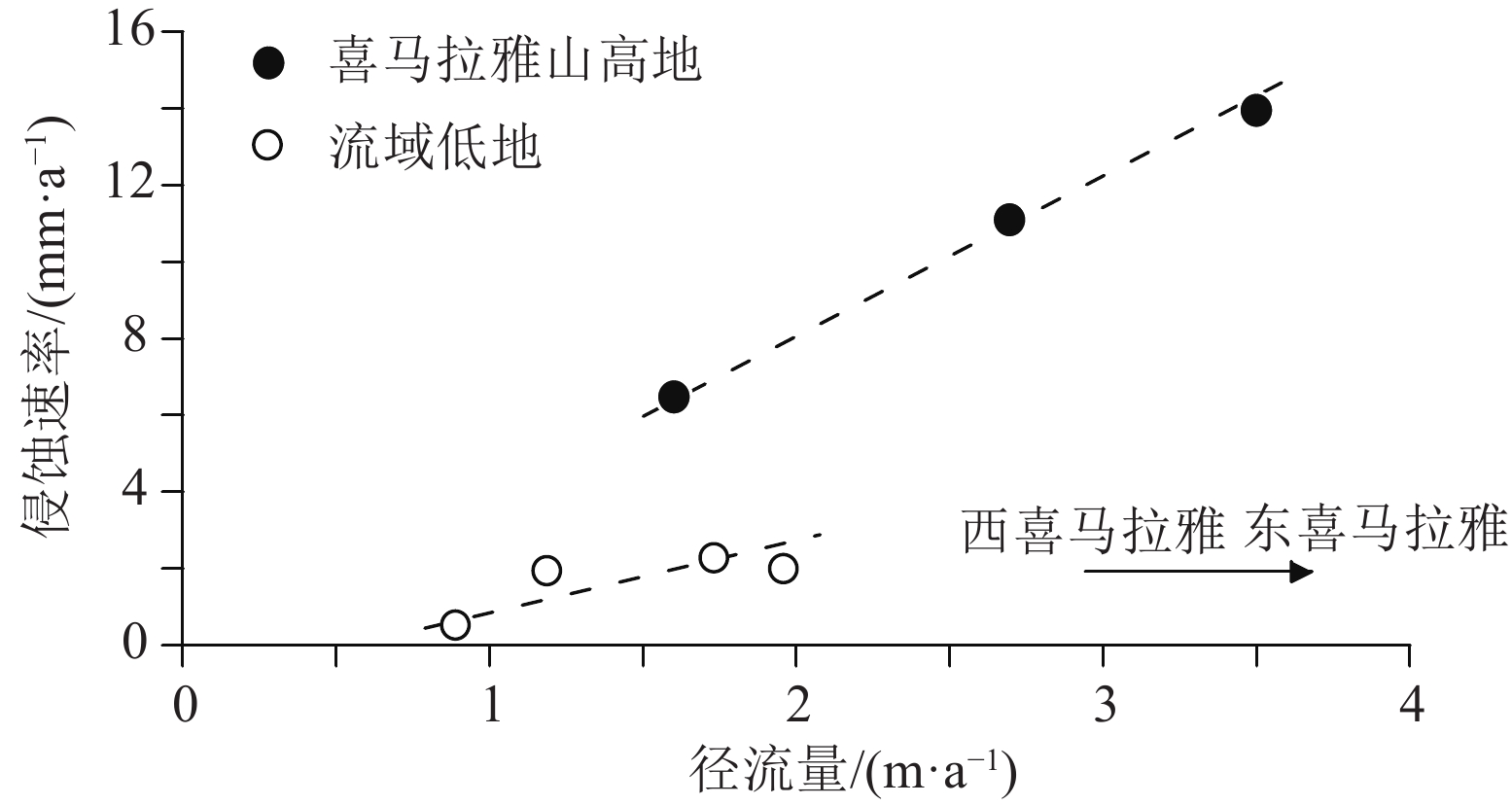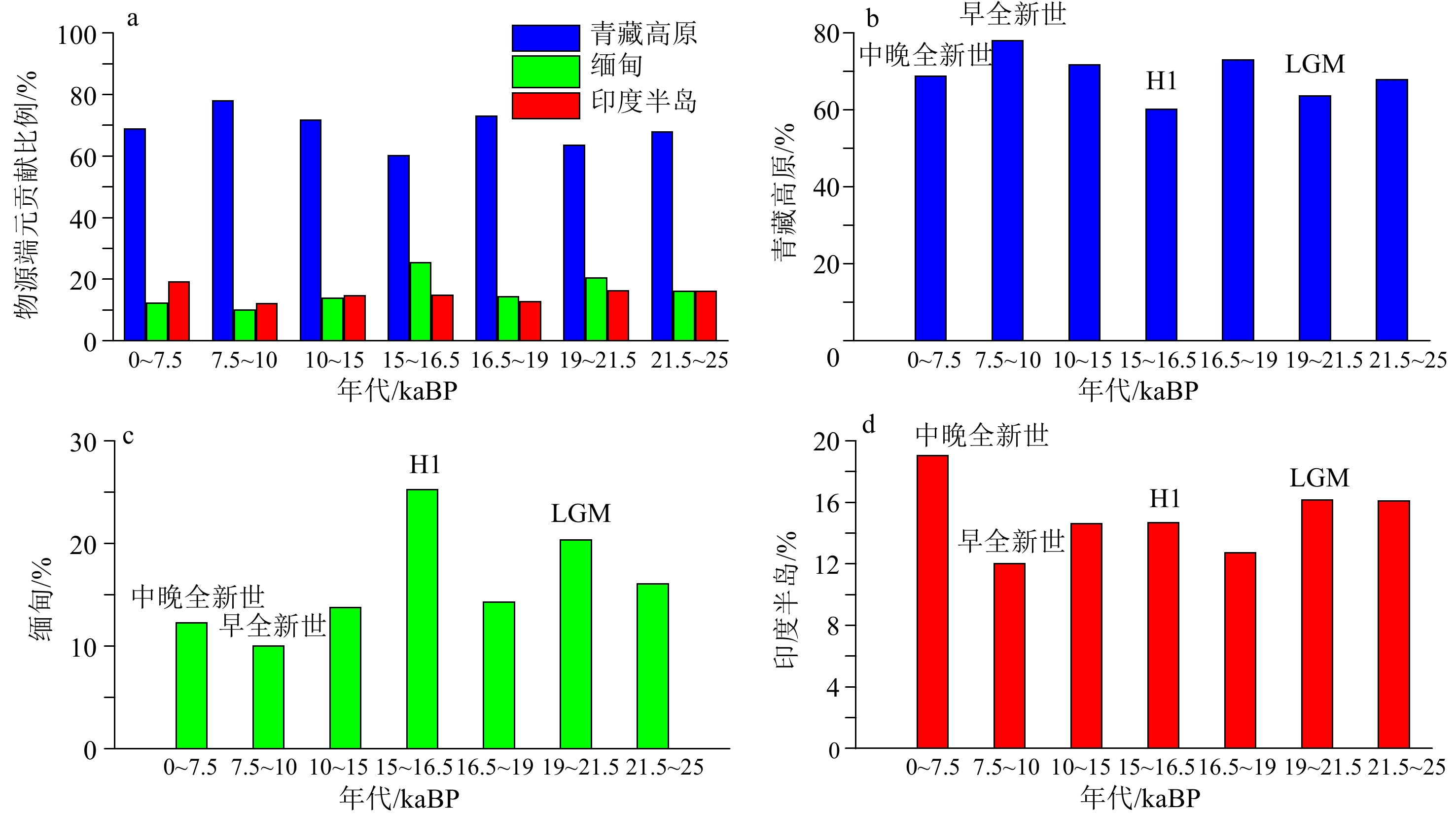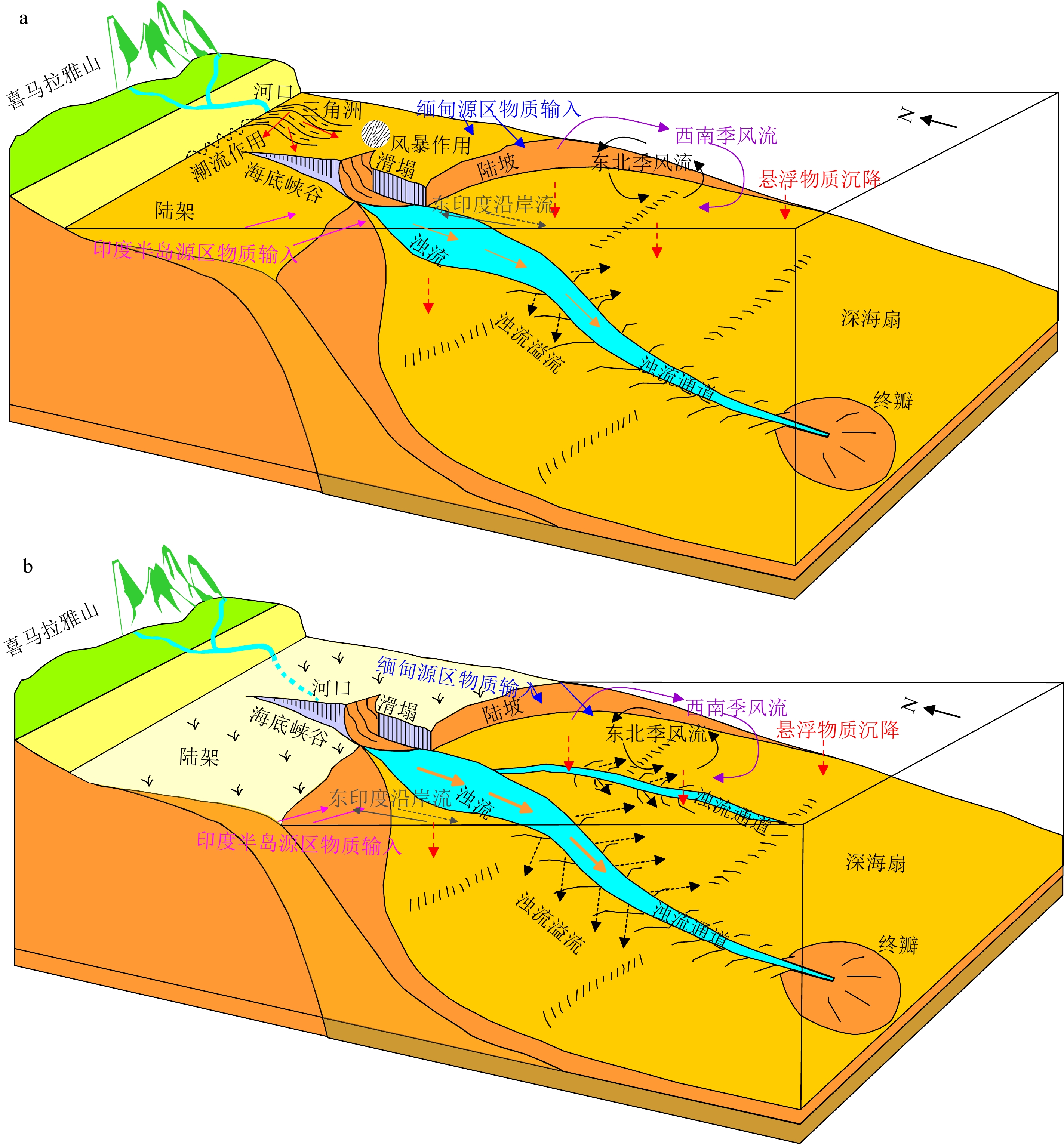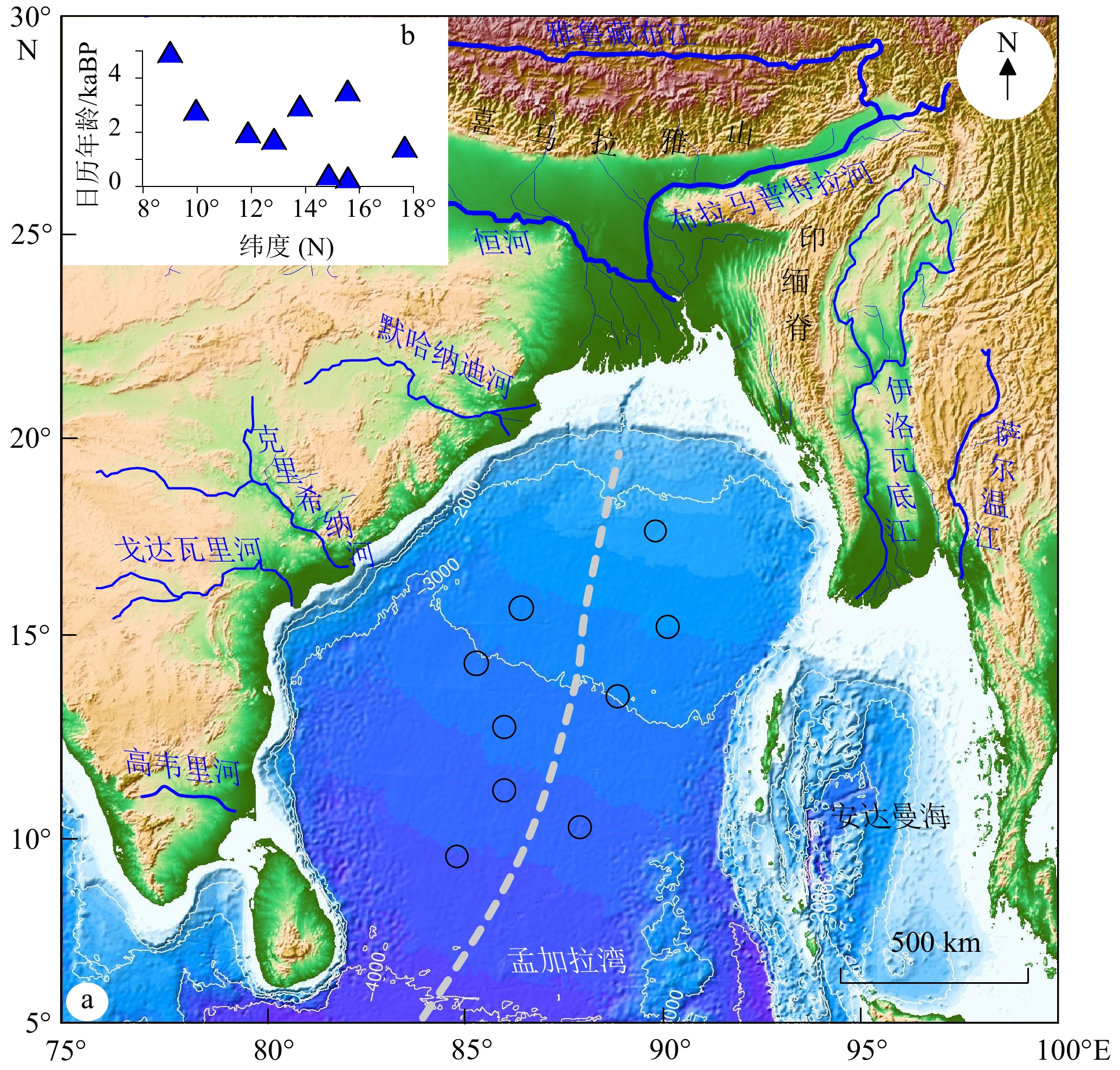Research progress of the Xizang Plateau - Bay of Bengal “source-sink” system since the Last Glacial Maximum
-
摘要:
近20年来,国际上对末次盛冰期以来青藏高原-孟加拉湾“源-汇”系统的研究取得了重要进展。为及时跟踪研究前沿,并进一步为地球系统科学思想指导下东北印度洋源汇过程研究提供新思路,本文按照从源到汇的思路,从流域风化侵蚀、海洋沉积物来源、沉积模式、源汇系统响应等几个方面总结了目前国内外最新研究进展,并指出了未来的主要突破方向。概括起来,主要取得如下认识:恒河-布拉马普特拉河流域尺度的物理侵蚀过程主要受控于季风气候变化,而化学风化过程与季风气候关系复杂,温度、降水、植被和冰川等因子在特定时期均可能起着重要的控制作用。孟加拉湾沉积物主要来自周边河流输入的流域风化产物,以恒河-布拉马普特拉河输入的青藏高原物质为主,同时也有部分来自印度半岛和缅甸的物质;末次盛冰期以来青藏高原源区物质贡献占据绝对优势(>70%),且整体变化不大,但各物源端元贡献比例在千年尺度上出现明显波动变化。孟加拉湾陆架发育典型的风暴控制型三角洲-陆架沉积,而底层浊流和表层环流作为孟加拉湾最重要的两个输运动力,对孟加拉湾深海扇沉积物组成和分布起着重要的控制作用。总体看来,末次盛冰期以来青藏高原-孟加拉湾“源-汇”系统演化主要受印度夏季风和海平面变化控制。未来的研究应以地球系统科学思想为指导,加强海陆结合的现代沉积过程的长期连续观测,聚焦沉积记录中环境替代指标的精确解译,揭示流域风化过程对季风气候变化的响应机制;结合数值模拟和海洋大数据分析,预测快速全球变化背景下青藏高原-孟加拉湾“源-汇”系统的演化趋势及环境效应,同时加强与世界大陆边缘其他典型源汇系统的比较研究。
Abstract:In the last two decades, significant approach has been made in the study on the Xizang Plateau (TP) - Bay of Bengal (BoB) “source-sink” system since the Last Glacial Maximum (LGM). To track the research frontiers and provide new ideas on the source-sink process of the Northeast Indian Ocean under the guidance of the thought of the earth system science, we summarized the latest progress in several aspects such as weathering and erosion, sediment provenance, sedimentary patterns, and source-sink system responses, and pointed out the breakthrough directions in the future. The physical erosion process in the Ganges-Brahmaputra (G-B) basin is primarily influenced by monsoon climate change, while the chemical weathering process exhibits a complex relationship with the monsoon climate. Temperature, precipitation, vegetation, and glaciers may all play significant roles in controlling these processes in specific times. The sediments in the BoB are mostly weathered products transported by surrounding rivers, particularly from the Ganges-Brahmaputra (G-B) River that transports great amounts of materials from the TP, and partially from Myanmar and Indian Peninsula. The TP has consistently contributed >70% terrigenous materials to the BoB with little changes since the LGM. However, contributions from each provenance varied significantly on a millennial scale. The BoB shelf developed typical storm-controlled delta-shelf deposits. As two most-significant regional transport driving forces, the bottom turbidity current and surface circulation had a crucial impact on the composition and distribution of deep-sea fan sediments. In general, the evolution of the TP - BoB “source-sink” system since the LGM is mainly controlled by the Indian Summer Monsoon (ISM) and sea level changes. In the future, more attention shall be paid to develop the joint land-sea long-term observation of modern deposition processes, and focus on the accurate interpretation of environmental signals in sedimentary records and response mechanism of weathering processes to monsoon climate change. With numerical simulation technology and marine big data, the evolution and environmental impacts of TP - BoB “source-sink” system under the fast global changes deserve more investigations. Meanwhile, comparative studies on other typical source-sink systems in the continental margins of the world shall be strengthened.
-

-
图 2 孟加拉湾周边物源端元贡献比例[57]
Figure 2.
图 3 孟加拉湾沉积模式图[55]
Figure 3.
-
[1] 石学法. 大洋钻探与中国边缘海沉积地质学[J]. 海洋科学, 1996, 20(3):47-50
SHI Xuefa. Ocean drilling and sedimentary geology of China marginal seas [J]. Marine Sciences, 1996, 20(3): 47-50.
[2] Kuehl S A, Yang S Y, Yu F K, et al. Asia’s mega rivers: Common source, diverse fates [J]. Eos, 2020, 101: 143936.
[3] 石学法, 乔淑卿, 杨守业, 等. 亚洲大陆边缘沉积学研究进展(2011-2020)[J]. 矿物岩石地球化学通报, 2021, 40(2):319-336
SHI Xuefa, QIAO Shuqing, YANG Shouye, et al. Progress in sedimentology research of the Asian continental margin (2011-2020) [J]. Bulletin of Mineralogy, Petrology and Geochemistry, 2021, 40(2): 319-336.
[4] 方念乔, 陈学方, 胡超涌, 等. 东北印度洋深海记录基本特征及其对青藏高原隆升的响应[J]. 第四纪研究, 2001, 21(6):490-499 doi: 10.3321/j.issn:1001-7410.2001.06.004
FANG Nianqiao, CHEN Xuefang, HU Chaoyong, et al. Deep sea sedimentary records in the northeastern Indian Ocean and their response to the uplift of the Qinghai-Xizang Plateau [J]. Quaternary Sciences, 2001, 21(6): 490-499. doi: 10.3321/j.issn:1001-7410.2001.06.004
[5] Curray J R. Sediment volume and mass beneath the Bay of Bengal [J]. Earth and Planetary Science Letters, 1994, 125(1-4): 371-383. doi: 10.1016/0012-821X(94)90227-5
[6] France-Lanord C, Derry L A. Organic carbon burial forcing of the carbon cycle from Himalayan erosion [J]. Nature, 1997, 390(6655): 65-67. doi: 10.1038/36324
[7] Weber M E, Reilly B T. Hemipelagic and turbiditic deposits constrain lower Bengal Fan depositional history through Pleistocene climate, monsoon, and sea level transitions [J]. Quaternary Science Review, 2018, 199: 159-173. doi: 10.1016/j.quascirev.2018.09.027
[8] Raymo M E, Ruddiman W F. Tectonic forcing of late Cenozoic climate [J]. Nature, 1992, 359(6391): 117-122. doi: 10.1038/359117a0
[9] Bufe A, Hovius N, Emberson R, et al. Co-variation of silicate, carbonate and sulfide weathering drives CO2 release with erosion [J]. Nature Geoscience, 2021, 14(4): 211-216. doi: 10.1038/s41561-021-00714-3
[10] Leland J, Reid M R, Burbank D W, et al. Incision and differential bedrock uplift along the Indus River near Nanga Parbat, Pakistan Himalaya, from 10Be and 26Al exposure age dating of bedrock straths [J]. Earth and Planetary Science Letters, 1998, 154(1-4): 93-107. doi: 10.1016/S0012-821X(97)00171-4
[11] Galy A, France-Lanord C. Higher erosion rates in the Himalaya: geochemical constraints on riverine fluxes [J]. Geology, 2001, 29(1): 23-26. doi: 10.1130/0091-7613(2001)029<0023:HERITH>2.0.CO;2
[12] Singh S K. Spatial variability in erosion in the Brahmaputra basin: Causes and impacts [J]. Current Science, 2006, 90(9): 1272-1276.
[13] Singh S K, Rai S K, Krishnaswami S. Sr and Nd isotopes in river sediments from the Ganga Basin: Sediment provenance and spatial variability in physical erosion [J]. Journal of Geophysical Research:Earth Surface, 2008, 113(F3): F03006.
[14] Kumar P, Sanwal J, Dimri A P, et al. Contribution of diverse monsoon precipitation over Central and Northern India during mid to Late Holocene [J]. Quaternary International, 2019, 507: 217-223. doi: 10.1016/j.quaint.2018.10.003
[15] Stewart R J, Hallet B, Zeitler P K, et al. Brahmaputra sediment flux dominated by highly localized rapid erosion from the easternmost Himalaya [J]. Geology, 2008, 36(9): 711-714. doi: 10.1130/G24890A.1
[16] Lupker M, France-Lanord C, Galy V, et al. Increasing chemical weathering in the Himalayan system since the Last Glacial Maximum [J]. Earth and Planetary Science Letters, 2013, 365: 243-252. doi: 10.1016/j.jpgl.2013.01.038
[17] Huyghe P, Guilbaud R, Bernet M, et al. Significance of the clay mineral distribution in fluvial sediments of the Neogene to Recent Himalayan Foreland Basin (west-central Nepal) [J]. Basin Research, 2011, 23(3): 332-345. doi: 10.1111/j.1365-2117.2010.00485.x
[18] Bohlin M S, Bickle M J. The reactive transport of Li as a monitor of weathering processes in kinetically limited weathering regimes [J]. Earth and Planetary Science Letters, 2019, 511: 233-243. doi: 10.1016/j.jpgl.2019.01.034
[19] Granet M, Chabaux F, Stille P, et al. Time-scales of sedimentary transfer and weathering processes from U-series nuclides: clues from the Himalayan rivers [J]. Earth and Planetary Science Letters, 2007, 261(3-4): 389-406. doi: 10.1016/j.jpgl.2007.07.012
[20] Granet M, Chabaux F, Stille P, et al. U-series disequilibria in suspended river sediments and implication for sediment transfer time in alluvial plains: the case of the Himalayan rivers [J]. Geochimica et Cosmochimica Acta, 2010, 74(10): 2851-2865. doi: 10.1016/j.gca.2010.02.016
[21] Heroy D C, Kuehl S A, Goodbred Jr S L. Mineralogy of the Ganges and Brahmaputra Rivers: implications for river switching and Late Quaternary climate change [J]. Sedimentary Geology, 2003, 155(3-4): 343-359. doi: 10.1016/S0037-0738(02)00186-0
[22] Khan H R, Liu J G, Liu S F, et al. Clay mineral compositions in surface sediments of the Ganges-Brahmaputra-Meghna river system of Bengal Basin, Bangladesh [J]. Marine Geology, 2019, 412: 27-36. doi: 10.1016/j.margeo.2019.03.007
[23] Lupker M, France-Lanord C, Galy V, et al. Predominant floodplain over mountain weathering of Himalayan sediments (Ganga basin) [J]. Geochimica et Cosmochimica Acta, 2012, 84: 410-432. doi: 10.1016/j.gca.2012.02.001
[24] Ayers J C, Patton B, Dietrich M. Preliminary evidence of transport-limited chemical weathering and element immobility in the Ganges tidal delta plain of Bangladesh [J]. Geochemistry, Geophysics, Geosystems, 2020, 21(8): e2020GC009029.
[25] Moon S, Huh Y, Qin J H, et al. Chemical weathering in the Hong (Red) River basin: rates of silicate weathering and their controlling factors [J]. Geochimica et Cosmochimica Acta, 2007, 71(6): 1411-1430. doi: 10.1016/j.gca.2006.12.004
[26] Clift P D, Giosan L, Blusztajn J, et al. Holocene erosion of the Lesser Himalaya triggered by intensified summer monsoon [J]. Geology, 2008, 36(1): 79-82. doi: 10.1130/G24315A.1
[27] Rahaman W, Singh S K, Sinha R, et al. Climate control on erosion distribution over the Himalaya during the past ~100 ka [J]. Geology, 2009, 37(6): 559-562. doi: 10.1130/G25425A.1
[28] Yu Z J, Colin C, Bassinot F, et al. Climate-driven weathering shifts between highlands and floodplains [J]. Geochemistry, Geophysics, Geosystems, 2020, 21(7): e2020GC008936.
[29] Duplessy J C. Glacial to interglacial contrasts in the northern Indian Ocean [J]. Nature, 1982, 295(5849): 494-498. doi: 10.1038/295494a0
[30] Sarkar A, Ramesh R, Bhattacharya S K, et al. Oxygen isotope evidence for a stronger winter monsoon current during the last glaciation [J]. Nature, 1990, 343(6258): 549-551. doi: 10.1038/343549a0
[31] Tiwari M, Ramesh R, Somayajulu B L K, et al. Early deglacial (~19-17 ka) strengthening of the northeast monsoon [J]. Geophysical Research Letters, 2005, 32(19): L19712.
[32] Caley T, Malaizé B, Zaragosi S, et al. New Arabian Sea records help decipher orbital timing of Indo-Asian monsoon [J]. Earth and Planetary Science Letters, 2011, 308(3-4): 433-444. doi: 10.1016/j.jpgl.2011.06.019
[33] Liu S F, Ye W X, Chen M T, et al. Millennial-scale variability of Indian summer monsoon during the last 42 kyr: Evidence based on foraminiferal Mg/Ca and oxygen isotope records from the central Bay of Bengal [J]. Palaeogeography, Palaeoclimatology, Palaeoecology, 2020, 562: 110112.
[34] Weldeab S, Rühlemann C, Bookhagen B, et al. Enhanced himalayan glacial melting during YD and H1 recorded in the northern bay of Bengal [J]. Geochemistry, Geophysics, Geosystems, 2019, 20(5): 2449-2461.
[35] Goodbred Jr S L. Response of the Ganges dispersal system to climate change: a source-to-sink view since the last interstade [J]. Sedimentary Geology, 2003, 162(1-2): 83-104. doi: 10.1016/S0037-0738(03)00217-3
[36] Ahmad S M, Babu G A, Padmakumari V M, et al. Sr, Nd isotopic evidence of terrigenous flux variations in the Bay of Bengal: Implications of monsoons during the last ~34, 000 years [J]. Geophysical Research Letters, 2005, 32(22): L22711.
[37] Panda D K, Kumar A, Mohanty S. Recent trends in sediment load of the tropical (Peninsular) river basins of India [J]. Global and Planetary Change, 2011, 75(3-4): 108-118. doi: 10.1016/j.gloplacha.2010.10.012
[38] Li J R, Liu S F, Shi X F, et al. Sedimentary responses to the sea level and Indian summer monsoon changes in the central Bay of Bengal since 40 ka [J]. Marine Geology, 2019, 415: 105947. doi: 10.1016/j.margeo.2019.05.006
[39] Ye W X, Liu S F, Fan D J, et al. Evolution of sediment provenances and transport processes in the central Bay of Bengal since the Last Glacial Maximum [J]. Quaternary International, 2022, 629: 27-35. doi: 10.1016/j.quaint.2020.12.007
[40] Ye W X, Liu S F, Li J R, et al. Sedimentary response to climate change in the central bay of Bengal since the last glacial maximum[J]. Lithosphere, 2022, 2022(Special 9): 3769093.
[41] Yu Z J, Colin C, Wilson D J, et al. Millennial variability in intermediate ocean circulation and Indian monsoonal weathering inputs during the last deglaciation and Holocene [J]. Geophysical Research Letters, 2022, 49(21): e2022GL100003.
[42] Bookhagen B, Thiede R C, Strecker M R. Late Quaternary intensified monsoon phases control landscape evolution in the northwest Himalaya [J]. Geology, 2005, 33(2): 149-152. doi: 10.1130/G20982.1
[43] Walker J C G, Hays P B, Kasting J F. A negative feedback mechanism for the long-term stabilization of Earth’s surface temperature [J]. Journal of Geophysical Research:Oceans, 1981, 86(C10): 9776-9782. doi: 10.1029/JC086iC10p09776
[44] Dosseto A, Vigier N, Joannes-Boyau R, et al. Rapid response of silicate weathering rates to climate change in the Himalaya [J]. Geochemical Perspectives Letters, 2015, 1(1): 10-19.
[45] Richards B W, Owen L A, Rhodes E J. Timing of late quaternary glaciations in the Himalayas of northern Pakistan [J]. Journal of Quaternary Science, 2000, 15(3): 283-297. doi: 10.1002/(SICI)1099-1417(200003)15:3<283::AID-JQS525>3.0.CO;2-X
[46] Owen L A, Finke R C, Caffee M W. A note on the extent of glaciation throughout the Himalaya during the global Last Glacial Maximum [J]. Quaternary Science Reviews, 2002, 21(1-3): 147-157. doi: 10.1016/S0277-3791(01)00104-4
[47] Owen L A, Finkel R C, Barnard P L, et al. Climatic and topographic controls on the style and timing of Late Quaternary glaciation throughout Xizang and the Himalaya defined by 10Be cosmogenic radionuclide surface exposure dating [J]. Quaternary Science Reviews, 2005, 24(12-13): 1391-1411. doi: 10.1016/j.quascirev.2004.10.014
[48] Owen L A, Dortch J M. Nature and timing of Quaternary glaciation in the Himalayan-Xizang orogen [J]. Quaternary Science Reviews, 2014, 88: 14-54. doi: 10.1016/j.quascirev.2013.11.016
[49] Hu G, Yi C L, Zhang J F, et al. Extensive glacial advances during the Last Glacial Maximum near the eastern Himalayan syntaxis [J]. Quaternary International, 2017, 443: 1-12.
[50] Hu G, Yi C L, Liu J H, et al. Glacial advances and stability of the moraine dam on Mount Namcha Barwa since the Last Glacial Maximum, eastern Himalayan syntaxis [J]. Geomorphology, 2020, 365: 107246. doi: 10.1016/j.geomorph.2020.107246
[51] Gabet E J, Burbank D W, Pratt-Sitaula B, et al. Modern erosion rates in the High Himalayas of Nepal [J]. Earth and Planetary Science Letters, 2008, 267(3-4): 482-494. doi: 10.1016/j.jpgl.2007.11.059
[52] Galy V, Francois L, France-Lanord C, et al. C4 plants decline in the Himalayan basin since the Last Glacial Maximum [J]. Quaternary Science Reviews, 2008, 27(13-14): 1396-1409. doi: 10.1016/j.quascirev.2008.04.005
[53] Tripathy G R, Singh S K, Ramaswamy V. Major and trace element geochemistry of Bay of Bengal sediments: Implications to provenances and their controlling factors [J]. Palaeogeography, Palaeoclimatology, Palaeoecology, 2014, 397: 20-30. doi: 10.1016/j.palaeo.2013.04.012
[54] Li J R, Liu S F, Feng X L, et al. Major and trace element geochemistry of the mid-Bay of Bengal surface sediments: implications for provenance [J]. Acta Oceanologica Sinica, 2017, 36(3): 82-90. doi: 10.1007/s13131-017-1041-z
[55] Li J R, Liu S F, Shi X F, et al. Distributions of clay minerals in surface sediments of the middle Bay of Bengal: Source and transport pattern [J]. Continental Shelf Research, 2017, 145: 59-67. doi: 10.1016/j.csr.2017.06.017
[56] Li J R, Liu S F, Shi X F, et al. Clay minerals and Sr-Nd isotopic composition of the Bay of Bengal sediments: Implications for sediment provenance and climate control since 40 ka [J]. Quaternary International, 2018, 493: 50-58. doi: 10.1016/j.quaint.2018.06.044
[57] Li J R, Liu S F, Shi X F, et al. Provenance of terrigenous sediments in the central Bay of Bengal and its relationship to climate changes since 25 ka [J]. Progress in Earth and Planetary Science, 2020, 7(1): 16. doi: 10.1186/s40645-020-00328-0
[58] Li J R, Shi X F, Liu S F, et al. Frequency of deep-sea turbidity as an important component of the response of a source-to-sink system to climate: a case study in the eastern middle Bengal Fan since 32 ka [J]. Marine Geology, 2021, 441: 106603. doi: 10.1016/j.margeo.2021.106603
[59] Sun X Q, Liu S F, Li J R, et al. Major and trace element compositions of surface sediments from the lower Bengal Fan: Implications for provenance discrimination and sedimentary environment [J]. Journal of Asian Earth Sciences, 2019, 184: 104000. doi: 10.1016/j.jseaes.2019.104000
[60] Sun X Q, Liu S F, Fang X S, et al. Clay minerals of surface sediments from the lower Bengal fan: implications for provenance identification and transport processes [J]. Geological Journal, 2020, 55(9): 6038-6048. doi: 10.1002/gj.3786
[61] Liu S F, Ye W X, Zhang H, et al. Sediment provenances shift driven by sea level and Indian monsoon in the southern Bay of Bengal since the last glacial maximum [J]. Frontiers in Marine Science, 2023, 10: 1106663. doi: 10.3389/fmars.2023.1106663
[62] Xue P F, Chang L, Wang S S, et al. Magnetic mineral tracing of sediment provenance in the central Bengal Fan [J]. Marine Geology, 2019, 415: 105955. doi: 10.1016/j.margeo.2019.05.014
[63] Colin C, Turpin L, Bertaux J, et al. Erosional history of the Himalayan and Burman ranges during the last two glacial–interglacial cycles [J]. Earth and Planetary Science Letters, 1999, 171(4): 647-660. doi: 10.1016/S0012-821X(99)00184-3
[64] Joussain R, Colin C, Liu Z F, et al. Climatic control of sediment transport from the Himalayas to the proximal NE Bengal Fan during the last glacial-interglacial cycle [J]. Quaternary Science Reviews, 2016, 148: 1-16. doi: 10.1016/j.quascirev.2016.06.016
[65] Song Z H, Wan S M, Colin C, et al. Paleoenvironmental evolution of South Asia and its link to Himalayan uplift and climatic change since the late Eocene [J]. Global and Planetary Change, 2021, 200: 103459. doi: 10.1016/j.gloplacha.2021.103459
[66] Prajith A, Tyagi A, Kurian P J. Changing sediment sources in the Bay of Bengal: evidence of summer monsoon intensification and ice-melt over Himalaya during the late Quaternary [J]. Palaeogeography, Palaeoclimatology, Palaeoecology, 2018, 511: 309-318. doi: 10.1016/j.palaeo.2018.08.016
[67] Singh M, Singh I B, Müller G. Sediment characteristics and transportation dynamics of the Ganga River [J]. Geomorphology, 2007, 86(1-2): 144-175. doi: 10.1016/j.geomorph.2006.08.011
[68] Kuehl S A, Hariu T M, Moore W S. Shelf sedimentation off the Ganges-Brahmaputra River system: evidence for sediment bypassing to the Bengal Fan [J]. Geology, 1989, 17(12): 1132-1135. doi: 10.1130/0091-7613(1989)017<1132:SSOTGB>2.3.CO;2
[69] Goodbred Jr S L, Saito Y. Tide-Dominated Deltas[M]//Davis R A, Dalrymple R W. Principles of Tidal Sedimentology. Dordrecht: Springer, 2012, 129-149.
[70] Michels K H, Kudrass H R, Hübscher C, et al. The submarine delta of the Ganges-Brahmaputra: cyclone-dominated sedimentation patterns [J]. Marine Geology, 1998, 149(1-4): 133-154. doi: 10.1016/S0025-3227(98)00021-8
[71] Brill D, Seeger K, Pint A, et al. Modern and historical tropical cyclone and tsunami deposits at the coast of Myanmar: implications for their identification and preservation in the geological record [J]. Sedimentology, 2020, 67(3): 1431-1459. doi: 10.1111/sed.12586
[72] Rogers K G, Goodbred Jr S L, Khan S R. Shelf-to-canyon connections: transport-related morphology and mass balance at the shallow-headed, rapidly aggrading swatch of no ground (Bay of Bengal) [J]. Marine Geology, 2015, 369: 288-299. doi: 10.1016/j.margeo.2015.09.011
[73] Rogers K G, Goodbred Jr S L. Mass failures associated with the passage of a large tropical cyclone over the Swatch of No Ground submarine canyon (Bay of Bengal) [J]. Geology, 2010, 38(11): 1051-1054. doi: 10.1130/G31181.1
[74] Hübscher C, Breitzke M, Michels K, et al. Late Quaternary seismic stratigraphy of the eastern Bengal Shelf [J]. Marine Geophysical Researches, 1998, 20(1): 57-71. doi: 10.1023/A:1004375908399
[75] Kudrass H R, Michels K H, Wiedicke M, et al. Cyclones and tides as feeders of a submarine canyon off Bangladesh [J]. Geology, 1998, 26(8): 715-718. doi: 10.1130/0091-7613(1998)026<0715:CATAFO>2.3.CO;2
[76] Kudrass H R, Machalett B, Palamenghi L, et al. Sediment transport by tropical cyclones recorded in a submarine canyon off Bangladesh [J]. Geo-Marine Letters, 2018, 38(6): 481-496. doi: 10.1007/s00367-018-0550-x
[77] Curray J R, Emmel F J, Moore D G. The Bengal Fan: morphology, geometry, stratigraphy, history and processes [J]. Marine and Petroleum Geology, 2002, 19(10): 1191-1223. doi: 10.1016/S0264-8172(03)00035-7
[78] Kuehl S A, Levy B M, Moore W S, et al. Subaqueous delta of the Ganges-Brahmaputra River system [J]. Marine Geology, 1997, 144(1-3): 81-96. doi: 10.1016/S0025-3227(97)00075-3
[79] Giosan L, Bhattacharya J. River Deltas-Concepts, Models, and Examples[M]//Kuehl S A, Allison M A, Goodbred S L, et al. The Ganges–Brahmaputra Delta. Tulsa: SEPM Special Publication, 2005: 413-434.
[80] Rudra K. Changing river courses in the western part of the Ganga–Brahmaputra delta [J]. Geomorphology, 2014, 227: 87-100. doi: 10.1016/j.geomorph.2014.05.013
[81] Sarkar A, Sengupta S, McArthur J M, et al. Evolution of Ganges–Brahmaputra western delta plain: Clues from sedimentology and carbon isotopes [J]. Quaternary Science Reviews, 2009, 28(25-26): 2564-2581. doi: 10.1016/j.quascirev.2009.05.016
[82] Wilson C A, Goodbred Jr S L. Construction and maintenance of the Ganges-Brahmaputra-Meghna delta: linking process, morphology, and stratigraphy [J]. Annual Review of Marine Science, 2015, 7: 67-88. doi: 10.1146/annurev-marine-010213-135032
[83] Fournier L, Fauquembergue K, Zaragosi S, et al. The Bengal fan: External controls on the Holocene Active Channel turbidite activity [J]. The Holocene, 2016, 27(6): 900-913.
[84] Fauquembergue K, Fournier L, Zaragosi S, et al. Factors controlling frequency of turbidites in the Bengal fan during the last 248 kyr cal BP: Clues from a presently inactive channel [J]. Marine Geology, 2019, 415: 105965. doi: 10.1016/j.margeo.2019.105965
[85] Weber M E, Wiedicke M H, Kudrass H R, et al. Active growth of the Bengal Fan during sea-level rise and highstand [J]. Geology, 1997, 25(4): 315-318. doi: 10.1130/0091-7613(1997)025<0315:AGOTBF>2.3.CO;2
[86] Chauhan O S, Vogelsang E. Climate induced changes in the circulation and dispersal patterns of the fluvial sources during late Quaternary in the middle Bengal Fan [J]. Journal of Earth System Science, 2006, 115(3): 379-386. doi: 10.1007/BF02702050
[87] Yang S Y, Bi L, Li C, et al. Major sinks of the Changjiang (Yangtze River)-derived sediments in the East China Sea during the late Quaternary[M]//Clift P D, Harff J, Wu J, et al. River-Dominated Shelf Sediments of East Asian Seas. London: Geological Society, 2016: 137.
[88] Milliman J D, Farnsworth K L. River Discharge to the Coastal Ocean[M]. New York: Cambridge University Press, 2001: 296-297.
[89] Cullen J L. Microfossil evidence for changing salinity patterns in the Bay of Bengal over the last 20000 years [J]. Palaeogeography, Palaeoclimatology, Palaeoecology, 1981, 35: 315-356. doi: 10.1016/0031-0182(81)90101-2
[90] Williams M A J, Clarke M F. Late Quaternary environments in north-central India [J]. Nature, 1984, 308(5960): 633-635. doi: 10.1038/308633a0
[91] Van Campo E. Monsoon fluctuations in two 20, 000-yr B. P. oxygen-isotope/pollen records off southwest India [J]. Quaternary Research, 1986, 26(3): 376-388. doi: 10.1016/0033-5894(86)90097-9
[92] Prell W L, Kutzbach J E. Monsoon variability over the past 150, 000 years [J]. Journal of Geophysical Research:Atmospheres, 1987, 92(D7): 8411-8425. doi: 10.1029/JD092iD07p08411
[93] Gasse F, Arnold M, Fontes J C, et al. A 13, 000-year climate record from western Xizang [J]. Nature, 1991, 353(6346): 742-745. doi: 10.1038/353742a0
[94] Singh I B. Geological evolution of Ganga Plain: an overview [J]. Journal of the Palaeontological Society of India, 1996, 41: 99-137.
[95] Hübscher C, Spieβ V, Breitzke M, et al. The youngest channel-levee system of the Bengal Fan: results from digital sediment echosounder data [J]. Marine Geology, 1997, 141(1-4): 125-145. doi: 10.1016/S0025-3227(97)00066-2
[96] Goodbred Jr S L, Kuehl S A. Holocene and modern sediment budgets for the Ganges-Brahmaputra river system: Evidence for highstand dispersal to flood-plain, shelf, and deep-sea depocenters [J]. Geology, 1999, 27(6): 559-562. doi: 10.1130/0091-7613(1999)027<0559:HAMSBF>2.3.CO;2
[97] Goodbred Jr S L, Kuehl S A. The significance of large sediment supply, active tectonism, and eustasy on margin sequence development: Late Quaternary stratigraphy and evolution of the Ganges-Brahmaputra delta [J]. Sedimentary Geology, 2000, 133(3-4): 227-248. doi: 10.1016/S0037-0738(00)00041-5
[98] Goodbred Jr S L, Kuehl S A. Enormous Ganges-Brahmaputra sediment discharge during strengthened early Holocene monsoon [J]. Geology, 2000, 28(12): 1083-1086. doi: 10.1130/0091-7613(2000)28<1083:EGSDDS>2.0.CO;2
[99] Monecke K, Winsemann J, Hanisch J. Climatic response of quaternary alluvial deposits in the upper Kali Gandaki valley (West Nepal) [J]. Global and Planetary Change, 2001, 28(1-4): 293-302. doi: 10.1016/S0921-8181(00)00080-1
[100] Shukla U K, Singh I B, Sharma M, et al. A model of alluvial megafan sedimentation: Ganga Megafan [J]. Sedimentary Geology, 2001, 144(3-4): 243-262. doi: 10.1016/S0037-0738(01)00060-4
[101] Pratt B, Burbank D W, Heimsath A, et al. Impulsive alluviation during early Holocene strengthened monsoons, central Nepal Himalaya [J]. Geology, 2002, 30(10): 911-914. doi: 10.1130/0091-7613(2002)030<0911:IADEHS>2.0.CO;2
[102] Finkel R C, Owen L A, Barnard P L, et al. Beryllium-10 dating of Mount Everest moraines indicates a strong monsoon influence and glacial synchroneity throughout the Himalaya [J]. Geology, 2003, 31(6): 561-564. doi: 10.1130/0091-7613(2003)031<0561:BDOMEM>2.0.CO;2
[103] Weber M E, Wiedicke-Hombach M, Kudrass H R, et al. Bengal Fan sediment transport activity and response to climate forcing inferred from sediment physical properties [J]. Sedimentary Geology, 2003, 155(3-4): 361-381. doi: 10.1016/S0037-0738(02)00187-2
[104] Wiedicke M, Kudrass H R, Hübscher C. Oolitic beach barriers of the last glacial sea-level lowstand at the outer Bengal shelf [J]. Marine Geology, 1999, 157(1-2): 7-18. doi: 10.1016/S0025-3227(98)00162-5
[105] Liu J G, He W, Cao L, et al. Staged fine-grained sediment supply from the Himalayas to the Bengal Fan in response to climate change over the past 50, 000 years [J]. Quaternary Science Reviews, 2019, 212: 164-177. doi: 10.1016/j.quascirev.2019.04.008
[106] Raff J L, Goodbred Jr S L, Pickering J L, et al. Sediment delivery to sustain the Ganges-Brahmaputra delta under climate change and anthropogenic impacts [J]. Nature Communications, 2023, 14(1): 2429. doi: 10.1038/s41467-023-38057-9
[107] 龚承林, 齐昆, 徐杰, 等. 深水源-汇系统对多尺度气候变化的过程响应与反馈机制[J]. 沉积学报, 2021, 39(1):231-252
GONG Chenglin, QI Kun, XU Jie, et al. Process-product linkages and feedback mechanisms of deepwater source-to-sink responses to multi-scale climate changes [J]. Acta Sedimentologica Sinica, 2021, 39(1): 231-252.
-




 下载:
下载:



